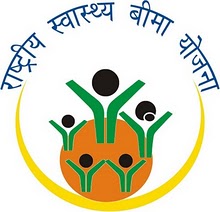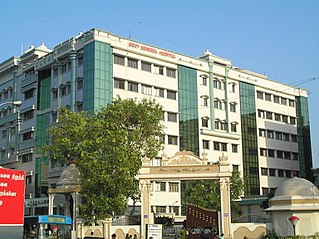Related Research Articles

Hyderabad is the capital and largest city of the Indian state of Telangana. It occupies 650 km2 (250 sq mi) on the Deccan Plateau along the banks of the Musi River, in the northern part of Southern India. With an average altitude of 542 m (1,778 ft), much of Hyderabad is situated on hilly terrain around artificial lakes, including the Hussain Sagar lake, predating the city's founding, in the north of the city centre. According to the 2011 Census of India, Hyderabad is the fourth-most populous city in India with a population of 6.9 million residents within the city limits, and has a population of 9.7 million residents in the metropolitan region, making it the sixth-most populous metropolitan area in India. With an output of US$74 billion, Hyderabad has the fifth-largest urban economy in India.

Publicly funded healthcare is a form of health care financing designed to meet the cost of all or most healthcare needs from a publicly managed fund. Usually this is under some form of democratic accountability, the right of access to which are set down in rules applying to the whole population contributing to the fund or receiving benefits from it.

Healthcare in Canada is delivered through the provincial and territorial systems of publicly funded health care, informally called Medicare. It is guided by the provisions of the Canada Health Act of 1984, and is universal. The 2002 Royal Commission, known as the Romanow Report, revealed that Canadians consider universal access to publicly funded health services as a "fundamental value that ensures national health care insurance for everyone wherever they live in the country."

Nizamabad, also known as Induru, is a city in the Indian state of Telangana. Nizamabad is a major urban agglomeration and third largest city in the state. It is governed by municipal corporation and is the headquarters of the Nizamabad district. Although previously part of Hyderabad State and then Andhra Pradesh state, Nizamabad became a part of the newly formed state of Telangana by the Andhra Pradesh Reorganisation Act, 2014. It is located about 186 kilometres (116 mi) north of the state capital, Hyderabad.

Apollo Hospitals Enterprise Limited is an Indian for-profit private hospital network headquartered in Chennai. It is the largest hospital chain in India, with a network of 71 owned and managed hospitals. Along with the eponymous hospital chain, the company also operates pharmacies, primary care and diagnostic centres, telehealth clinics, and digital healthcare services among others through its subsidiaries.
A public hospital, or government hospital, is a hospital which is government owned and is fully funded by the government and operates solely off the money that is collected from taxpayers to fund healthcare initiatives. In some countries, this type of hospital provides medical care free of charge to patients, covering expenses and wages by government reimbursement.
Health care in Saudi Arabia is a national health care system in which the government provides free universal healthcare coverage through a number of government agencies. There is also a growing role and increased participation from the private sector in the provision of health care services. Saudi Arabia has been ranked among the 26 best countries in providing high quality healthcare.

Healthcare in Mexico is provided by public institutions run by government departments, private hospitals and clinics, and private physicians. It is largely characterized by a special combination of coverage mainly based on the employment status of the people. Every Mexican citizen is guaranteed no cost access to healthcare and medicine according to the Mexican constitution and made a reality with the “Institute of Health for Well-being”, or INSABI.

Healthcare in Singapore is under the purview of the Ministry of Health of the Government of Singapore. It mainly consists of a government-run publicly funded universal healthcare system as well as a significant private healthcare sector. Financing of healthcare costs is done through a mixture of direct government subsidies, compulsory comprehensive savings, national healthcare insurance, and cost-sharing.

Medical tourism is a growing sector in India. In mid–2020, India's medical tourism sector was estimated to be worth US$5–6 billion. In 2017, 495,056 patients visited India to seek medical care. According to a report from 2019 by the Federation of Indian Chambers of Commerce and Industry and Ernst & Young, most of the medical tourist arrivals in India were from Southeast Asia, Middle East, Africa, and SAARC region. India also receives significant number of medical tourists from Australia, Canada, China, Russia, the United Kingdom, and the United States. The city of Chennai has come to be known as the healthcare capital of India.

Rashtriya Swasthya Bima Yojana is a government-run health insurance programme for the Indian poor. The scheme aims to provide health insurance coverage to the unrecognised sector workers belonging to the BPL category and their family members shall be beneficiaries under this scheme. It provides for cashless insurance for hospitalisation in public as well as private hospitals. The scheme started enrolling on April 1, 2008 and has been implemented in 25 states of India. A total of 36 million families have been enrolled as of February 2014. Initially, RSBY was a project under the Ministry of Labour and Employment. Now it has been transferred to Ministry of Health and Family Welfare from April 1, 2015

The National Health Mission (NHM) was launched by the government of India in 2005 subsuming the National Rural Health Mission and National Urban Health Mission. It was further extended in March 2018, to continue until March 2020. It is headed by Mission Director and monitored by National Level Monitors appointed by the Government of India.Rural Health Mission (NRHM) and the recently launched National Urban Health Mission (NUHM). Main program components include Health System Strengthening (RMNCH+A) in rural and urban areas- Reproductive-Maternal- Neonatal-Child and Adolescent Health, and Communicable and Non-Communicable Diseases. NHM envisages achievement of universal access to equitable, affordable and quality health care services that are accountable and responsive to the needs of the people.

AMRI Hospitals is a for-profit private hospital chain which is headquartered in the city of Kolkata, West Bengal, India. The hospitals are accredited by NABH. The company's head office is in Kolkata, West Bengal, with 3 units in Kolkata, 1 clinic in Kolkata and 1 unit Bhubaneshwar in the Indian State of Odisha. The hospital had also opened a health center in Dhaka for its Bangladeshi patients.
Examples of health care systems of the world, sorted by continent, are as follows.
The public healthcare system in India evolved due to a number of influences since 1947, including British influence from the colonial period. The need for an efficient and effective public health system in India is large. Public health system across nations is a conglomeration of all organized activities that prevent disease, prolong life and promote health and efficiency of its people. Indian healthcare system has been historically dominated by provisioning of medical care and neglected public health. 11.9% of all maternal deaths and 18% of all infant mortality in the world occurs in India, ranking it the highest in the world. 36.6 out of 1000 children are dead by the time they reach the age of 5. 62% of children are immunized. Communicable disease is the cause of death for 53% of all deaths in India.
Healthcare in Tripura features a universal health care system run by the state government. The Constitution of India charges every state with "raising of the level of nutrition and the standard of living of its people and the improvement of public health as among its primary duties". Ministry of Health & Family Welfare of the Government of Tripura is responsible for healthcare administration in the state.

Healthcare in Chennai is provided by both government-run and private hospitals. Chennai attracts about 45 percent of health tourists from abroad arriving in the country and 30 to 40 percent of domestic health tourists. The city has been termed India's health capital. Multi- and super-specialty hospitals across the city bring in an estimated 150 international patients every day. Factors behind the tourists' inflow in the city include low costs, little to no waiting period, and facilities offered at the speciality hospitals in the city.

India has a multi-payer universal health care model that is paid for by a combination of public and private health insurance funds along with the element of almost entirely tax-funded public hospitals. The public hospital system is essentially free for all Indian residents except for small, often symbolic co-payments in some services.

The Egyptian healthcare system is pluralistic, comprising a variety of healthcare providers from the public as well as the private sector. The government ensures basic universal health coverage, although private services are also available for those with the ability to pay. Due to social and economic pressures, Egypt's healthcare system is subject to many challenges. However, several recent efforts have been directed towards enhancing the system.
References
- ↑ "Government Hospitals". Greater Hyderabad Municipal Corporation . 2011. Archived from the original on 15 January 2012. Retrieved 9 May 2012.
- ↑ "Bed Strength of Hospitals under DME". Government of Andhra Pradesh . 2002. Archived from the original on 9 March 2012. Retrieved 6 May 2012.
- ↑ "Healthcare sector takes a leap in city". The Hindu . 18 January 2012. Retrieved 6 May 2012.
- ↑ Gopal Bhargava and Shankarlal Bhatt (2006). Land and people of Indian states and union territories. p. 132. ISBN 81-7835-358-X . Retrieved 6 May 2012.
{{cite book}}:|work=ignored (help) - ↑ "Health and Living Conditions in Eight Indian Citie" (PDF). National Family Health Survey,India 2005-06. 2006. p. 44,55,56,57,60,61. Retrieved 7 May 2012.
- ↑ "Fat of the Matter". The Hindu. Retrieved 21 August 2013.